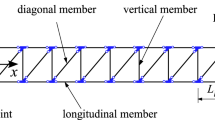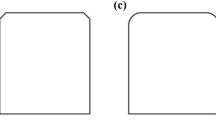Abstract
In this study a 3D numerical analysis approach is developed to predict the ground vibration around rigid-frame viaducts induced by running high-speed trains. The train-bridge-ground interaction system is divided into two subsystems: the train-bridge interaction and the soil-structure interaction. First, the analytical program to simulate bridge vibration with consideration of train-bridge interaction is developed to obtain the vibration reaction forces at the pier bottoms. The highspeed train is described by a multi-DOFs vibration system and the rigid-frame viaduct is modeled with 3D beam elements. Second, applying these vibration reaction forces as input external excitations, the ground vibration is simulated by using a general-purpose program that includes soil-structure interaction effects. The validity of the analytical procedure is confirmed by comparing analytical and experimental results. The characteristics of high-speed train-induced vibrations, including the location of predominant vibration, are clarified. Based on this information a proposed vibration countermeasure using steel strut and new barrier is found effective in reducing train-induced vibrations and it satisfies environmental vibration requirements. The vibration screening efficiency is evaluated by reduction VAL based on 1/3 octave band spectral analysis.
Similar content being viewed by others
References
Alzawi A and El Naggar MH (2011), “Full Scale Experimental Study on Vibration Scattering Using Open and In-filled (GeoFoam) Wave Barriers,” Soil Dynamics and Earthquake Engineering, 31(3): 306–317.
Cao YM, Xia H and Li ZH (2012), “A Semi-analytical/FEM Model for Predicting Ground Vibrations Induced by High-speed Train through Continuous Girder Bridge,” Journal of Mechanical Science and Technology, 26(8): 2485–2496.
Chen F, Takemiya H and Huang MS (2010), “Prediction and Mitigation Analyses of Ground Vibrations Induced by High Speed Train with 3-dimensional Finite Element Method and Substructure Method,” Journal of Vibration and Control, 17(11): 1703–1720.
Chen G and Zhai WM (1999), “Numerical Simulation of the Stochastic Process of Railway Track Irregularities,” Journal of Southwest Jiaotong University, 34(2): 138–142. (in Chinese)
Galvín P and Domínguez J (2009), “Experimental and Numerical Analyses of Vibrations Induced by High-speed Trains on the Córdoba-Málaga Line,” Soil Dynamics and Earthquake Engineering, 29(4): 641–657.
Hara T, Yoshioka O, Kanda H, Funabashi H, Negishi H, Fujino Y and Yoshida K (2004), “Development of a New Method to Reduce Shinkansen-induced Wayside Vibrations Applicable to Rigid Frame Bridges: Bridgeend Reinforcing Method,” Journal of Structural and Earthquake Engineering, JSCE, 68(7): 325–338. (in Japanese)
He XW, Kawatani M and Nishiyama S (2010), “An Analytical Approach to Train-induced Site Vibration Around Shinkansen Viaducts,” Structure and Infrastructure Engineering, 6(6): 689–701.
Hung HH, Yang YB and Chang DW (2004), “Wave Barriers for Reduction of Train-induced Vibrations in Soils,” Journal of Geotechnical and Geoenvironmental Engineering, ASCE, 130(12): 1283–1291.
Ju SH and Li HC (2011), “3D Analyses of Open Trench Barriers Filled with Water,” Journal of Geotechnical and Geoenvironmental Engineering, ASCE, 137(11): 1114–1120.
Ju SH, Lin HT and Chen TK (2007), “Studying Characteristics of Train-induced Ground Vibrations Adjacent to an Elevated Railway by Field Experiments,” Journal of Geotechnical and Geoenvironmental Engineering, ASCE, 133(10): 1302–1307.
Kawatani M, He XW, Shiraga R, Seki M, Nishiyama S and Yoshida K (2006), “Dynamic Response Analysis of Elevated Railway Bridges due to Shinkansen Trains,” Journal of Structural and Earthquake Engineering, JSCE, 62(3): 509–519. (in Japanese)
Lombaert G and Degrande G (2009), “Ground-borne Vibration due to Static and Dynamic Axle Loads of Intercity and High-speed Trains,” Journal of Sound and Vibration, 319(3-5): 1036–1066.
Lysmer J, Ostadan F and Chin CC (1999), SASSI 2000 Theoretical Manual & User’s Manual–A System for Analysis of Soil-structure Interaction, Academic Version, University of California, Berkeley.
Matsuura A (1998), “Simulation for Analyzing Direct Derailment Limit of Running Vehicle on Oscillating Tracks,” Journal of Structural and Earthquake Engineering, JSCE, 15(1): 63–72.
Ministry of the Environment, Government of Japan (1976), Recommendation for Anti-vibration Measures Against Shinkansen Trains for Urgent Environmental Conservation.
Nishimura A (1999), “A Study on Integrity Assessment of Railway Rigid Frame Bridge,” RTRI Report, 4(9): 14–21. (in Japanese)
Railway Technical Research Institute (RTRI) (1997), Design Standard for Railway Structures (Foundation and Soil Pressure Resistance Structures), Maruzen Co., Ltd., Tokyo, Japan. (in Japanese)
Sheng X, Jones CJC and Petyt M (1999), “Ground Vibration Generated by a Harmonic Load Acting on a Railway Track,” Journal of Sound and Vibration, 225(1): 3–28.
Su D, Fujino Y, Nagayama T, Hernandez Jr JY and Seki M (2010), “Vibration of Reinforced Concrete Viaducts under High-speed Train Passage: Measurement and Prediction Including Train-viaduct Interaction,” Structure and Infrastructure Engineering, 6(5): 621–633.
Takemiya H (2004), “Field Vibration Mitigation by Honeycomb WIB for Pile Foundations of a Highspeed Train Viaduct,” Soil Dynamics and Earthquake Engineering, 24(1): 69–87.
Takemiya H (2008), “Analyses of Wave Field from Highspeed Train on Viaduct at Shallow/Deep Soft Grounds,” Journal of Sound and Vibration, 310(3): 631–649.
Takemiya H and Bian XC (2007), “Shinkansen Highspeed Train Induced Ground Vibrations in View of Viaduct-ground Interaction,” Soil Dynamics and Earthquake Engineering, 27(6): 506–520.
Wu YS and Yang YB (2004), “A Semi-analytical Approach for Analyzing Ground Vibrations Caused by Trains Moving over Elevated Bridges,” Soil Dynnamics and Earthquake Engineering, 24(12): 949–962.
Xia H, Cao YM and De Roeck G (2010), “Theoretical Modeling and Characteristic Analysis of Moving-train Induced Ground Vibrations,” Journal of Sound and Vibration, 329(7): 819–832.
Xia H, Zhang N and Gao R (2005), “Experimental Analysis of Railway Bridge under High-speed Trains,” Journal of Sound and Vibration, 282(2): 517–528.
Yokoyama H, Yashiro K, Kamohara A and Iwata N (2011), “Propagation Characteristics of Horizontal and Vertical Component of Train-induced Ground Vibration,” RTRI Report, 25(11): 35–40. (in Japanese)
Yoshida K and Seki M (2004), “Influence of Improved Rigidity in Railway Viaducts on the Environmental Ground Vibration,” Journal of Structural Engineering, JSCE, Vol.50A, 403–412. (in Japanese)
Yoshioka O (2000), “Basic Characteristics of Shinkanseninduced Ground Vibration and Its Reduction Measures,” Proc. WAVE2000, Bochum, Germany, 219–237.
Zhai WM, He ZX and Song XL (2010), “Prediction of High-speed Train Induced Ground Vibration Based on Train-track-ground System Model,” Earthquake Engineering and Engineering Vibration, 9(4): 545–554.
Author information
Authors and Affiliations
Corresponding author
Additional information
Supported by: Doctoral Scientific Research Startup Foundation of Wuhan University of Technology, China (No. 40120246); Hubei Key Laboratory of Roadway Bridge and Structure Engineering (Wuhan University of Technology) (No. DQJJ201505)
Rights and permissions
About this article
Cite this article
Sun, L., Xie, W., He, X. et al. Prediction and mitigation analysis of ground vibration caused by running high-speed trains on rigid-frame viaducts. Earthq. Eng. Eng. Vib. 15, 31–47 (2016). https://doi.org/10.1007/s11803-016-0303-7
Received:
Accepted:
Published:
Issue Date:
DOI: https://doi.org/10.1007/s11803-016-0303-7




